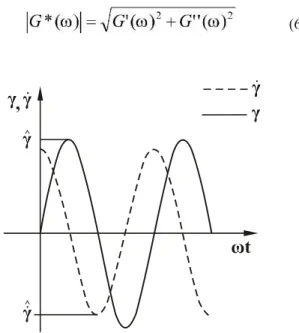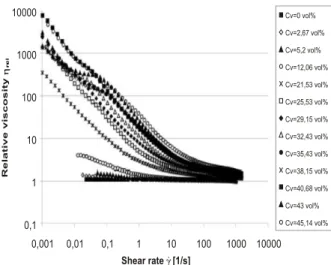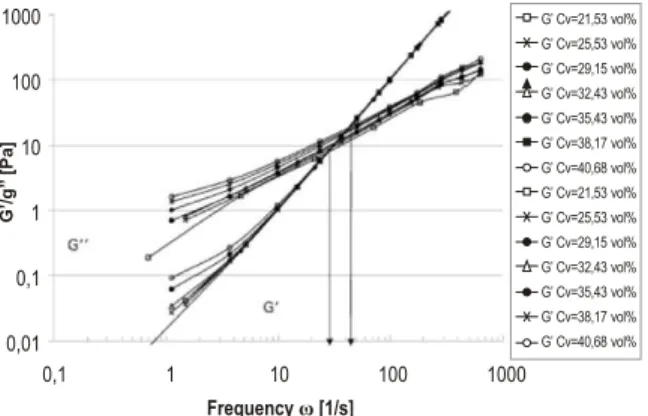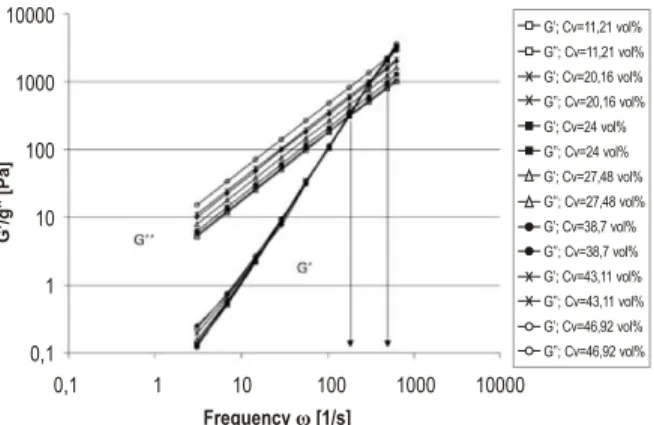Ulrich Teipel*
Georg-Simon-Ohm University Nuremberg - Germany ulrich.teipel@ohm-hochschule.de
Ulrich Förter-Barth
Institut Chemische Technologie Pfinztal - Germany
*author for correspondence
Rheology of suspensions with
aluminum nano-particles
Abstract: Nano-scale aluminum particles are innovative materials increasingly
used in energetic formulations. In this contribution, the rheological behavior of suspensions with either paraffin oil or HTPB as the matrix fluid and nano-scale aluminum (ALEX) as the dispersed phase is described and discussed. The paraffin oil/aluminum suspensions exhibit non-Newtonian flow behavior over a wide range of concentrations, whereas the HTPB/aluminum suspensions exhibit Newtonian behavior (i.e. the viscosity is independent of shear stress) up to a concentration of 50 vol.% aluminum. Both systems have unusual viscoelastic properties in that their elastic moduli are independent of the solids concentration.
Key words: Aluminum nano-particles, Rheology, ALEX, HTPB, Viscoelastic
properties
LIST OF SYMBOLS
.
η(γ) Flow properties At such small sizes, interparticle interactions become
γ Deformation significantly more important and, as a result, nano-scale
^
γ Amplitude particles have a higher tendency to agglomerate (Glotov,
ω Radial frequency 2000).
τ(t) Sinusoidal shear stress
δ Phase shift In addition, the changed material poses difficulties when G*(ω) Shear modulus they are mixed with a fluid polymer matrix. This work G'(ω) Storage modulus examines and discusses the rheological properties of G''(ω) Loss modulus suspensions containing nano-scale aluminum particles in
η Dynamic viscosity of steady state and oscillatory shear flows.
ρ Density
S Specific surface EXPERIMENTAL Measurement Methods INTRODUCTION
The rheological behavior of suspensions filled with Aluminum particles are well known as an ingredient in nanoscale aluminum was examined in steady state and energetic materials. The typical diameter of aluminum used oscillatory shear flow using a UDS 200 rotational in explosives and propellants is in the order of ~ 30 µm rheometer manufactured by Physica Meßtechnik GmbH. (Miller, 1991). To enhance aluminum reactivity, for The measurement fixtures included a modified coaxial instance during combustion of solid rocket propellants, it is cylinder (Mooney-Ewart-System) and a cone and plate. advantageous to use particles with the largest possible Under steady state shear flow, the characteristic material specific surface area, i.e., particles with a smaller mean function can be described as follows:
particle size are desirable. By vaporizing and subsequently
condensing aluminum in argon, or by electric explosion of (1) an aluminum wire, it is possible to produce aluminum .
η γ)
Here, ( is a characteristic material function that particles in the nanometer size range (Ivanov and Tepper
describes the flow properties when the fluid is subjected to a 1997, Tepper and Ivanov 1998). Particles in this size range
rheometric flow. exhibit physical properties very different than those in the
micrometer range.
In oscillatory shear flow, the fluid is subjected to a periodic
^
(e.g., sinusoidal) deformation (t) with an amplitude γat a At such small sizes, interparticle interactions become γ
radial frequencyω= 2πf (Fig. 1) (Teipel, 1999): significantly more important and, as a result, nano-scale
particles have a higher tendency to agglomerate (Glotov,
(2) 2000).
____________________________________ Subjecting the material to an oscillatory (sinusoidal) shear
Received: 30/04/09 deformation at sufficiently small amplitudes, i.e. in the
τ(t) output (Fig. 2). Viscoelastic material behavior is linear viscoelastic region, the moduli G'(ω), G''(ω) and characterized by the existence of a phase shift δ between the G*(ω) are independent of the oscillatory amplitude in tests shear stress output τ(t) and the deformation input γ(t): conducted at a constant frequency. The mean particle size and particle size distribution of the aluminum were determined via laser diffraction spectrometry or photon (3)
correlation spectroscopy. Scanning electron micrographs were accomplished to further characterize the material. By definition, the phase shift of a perfectly elastic solid is
zero and that of a purely viscous fluid is π/2, whereas for viscoelastic fluids it is 0<δ<π/2. The shear stress function can be described in terms of the frequency dependent complex shear modulus G*(ω),
(4)
The complex shear modulus can also be expressed as
(5)
The complex shear modulus G*(ω) of a viscoelastic material is composed of two material functions, a real and an imaginary component, called the storage modulus,
Figure 2: Shear stress profile of a viscoelastic fluid resulting from
G'(ω), and the loss modulus, G''(ω), respectively. The
an oscillatory shear deformation.
storage modulus G'(ω) is proportional to the deformation energy stored by the material (the elastic component), while the loss modulus G''(ω) is proportional to the amount of
Materials
energy dissipated by the material (the viscous component).
The suspensions investigated consisted of nano-scale aluminum particles dispersed in paraffin oil or hydroxyl-(6)
terminated polybutadiene (HTPB). The paraffin oil exhibited Newtonian flow behavior with a dynamic
3
viscosity of η(20 °C) = 198 mPas. It had a ρ = 874.7 kg/m density and a σ = 30.5 mN/m surface tension. The hydroxy-terminated polybutadiene (designated HTPB R 45-M) also exhibited Newtonian flow behavior with a dynamic viscosity of η(20 °C) = 9300 mPas.
The nano-scale aluminum (ALEX) was obtained from Argonide Corporation, Stanford, Florida/USA. The density of the aluminum particles was determined by gas
3
pycnometry to be ρ = 2.4 g/m and the specific surface area
2
determined by gas adsorption was S = 11.2 m /g. A SEM image of the aluminum powder is shown in Fig. 3
Figure 1: Deformation and shear rate profiles in oscillatory shear flow.
Oscillatory shear experiments must be conducted at deformations within the material's linear viscoelastic range. In this range, at a constant radial frequency , the
^
deformation amplitude γ is proportional to the resulting
^ ^ ^
shear stress amplitude τ, i.e., τ~γ: This is only the case for
sufficiently small oscillatory deformations. Within the Figure 3: Nano-scale aluminum powder. ^.
γ
^
RESULTS viscosity is much less pronounced at higher shear rates because of the flow induced structuring of the system.
Flow Behavior of the Paraffin Oil/Aluminum Figure 5 shows the relative viscosity of the suspension as a
Suspensions function of solids concentration for the limiting viscosity at . .
zero shear rate ( γ→ 0) and at a relatively high shear rate, γ =
-1
Prior to the rheological characterization, the paraffin oil/ 1000 s . aluminum suspensions were stirred for a number of hours
and the aluminum was well dispersed using an ultrasound homogenizer. This process ensured that aluminum agglomerates were broken down and the suspension was adequately homogenized. After mixing, the flow behavior was characterized under steady shear flow. Fig. 4 illustrates the relative viscosity as a function of shear rate for the suspensions, which ranged in solids concentration from 2 to 45 vol.%, as well as for the pure paraffin oil.
Figure 5: Relative viscosity of paraffin oil/aluminum suspensions as a function of solids concentration.
At the highest shear rate examined, a linear increase in the relative viscosity as a function of solids concentration is
~
observed, up to a CV ~25 vol.% concentration. At very low
concentrations, there is almost no difference in the relative viscosity determined at the minimum and maximum shear rate. In this range of concentration, sufficient distance between the particles contributes to small particleparticle interactions, and likewise flow induced orientation of the
Figure 4: Relative viscosity of the paraffin oil/aluminum
particles has a relatively minor effect on the viscosity.
suspensions as a function of shear rate; = 20 °C.
Increasing the concentration leads to an increased contribution of the viscosity from particleparticle interactions. The quiescent particle structure formed with The relative viscosity rel is defined as the ratio of the
increasing concentration at low shear rates is one of the viscosity of the suspension to that of the matrix fluid at a .
reasons for the strong concentration dependence of the constant shear rate γ:
limiting viscosity at zero shear rate, as shown in Fig. 5. At higher shear rates a flow induced structure is formed leading to a reduction in the relative viscosity at a given (7)
solids concentration. The difference of the viscosity With increasing aluminum concentration the suspensions function at the two shear rates γ.→ 0 and .γ = 1000 s , which -1
exhibit more and more distinct shear thinning behavior.
increases with increasing solids concentration, can be This non-Newtonian response can be attributed to
attributed primarily to the behavior of the particles in the particleparticle interactions and the changed
Couette flow. At a concentration of 45 vol.%, the viscosity hydrodynamics of the suspension compared to the single
difference is nearly of the order of 104. phase fluid. At small shear rates, the viscosity increase as a
function of concentration is particularly pronounced. In this shear rate range, the interparticle forces dominate the
Flow Behavior of HTPB/Aluminum Suspensions
relatively weak hydrodynamic forces, so that the rheological response of the suspension is strongly
Figure 6 shows the relative viscosity of the dependent on the solids concentration and the resulting
HTPB/aluminum suspensions as a function of shear rate for structural interactions. As the shear rate is increased, the
solids concentrations from 0 < C < 47 vol.%. Hydroxy-hydrodynamic forces also increase, leading to flow induced V
terminated polybutadiene, HTPB R 45-M, without structuring of the nano-scale particles and a corresponding
additives exhibits Newtonian flow behavior, see Fig. 6 decrease in the viscosity at a given solids concentration.
(Hordijk, 1996 and Muthiah, 1996). The effect of solids concentration on the suspension
10000
1000
100
10
1
0,1
0,001 0,01 0,1 1 10 100 1000 10000
Rel
a
ti
v
e
v
is
c
o
s
ity
.
Shear rate γ[1/s]
Cv=0 vol% Cv=2,67 vol% Cv=5,2 vol% Cv=12,06 vol% Cv=21,53 vol% Cv=25,53 vol% Cv=29,15 vol% Cv=32,43 vol% Cv=35,43 vol% Cv=38,15 vol% Cv=40,68 vol% Cv=43 vol% Cv=45,14 vol%
0,001 0,01 0,1 1 10 100 1000
R
el
a
ti
v
e
v
is
c
o
s
ity
.
Shear rate γ[1/s]
pure HTPB Cv=2,48 vol% Cv=4,81 vol% Cv=11,21 vol% Cv=20,16 vol% Cv=24 vol% Cv=27,48 vol% Cv=38,7 vol% Cv=46,92 vol%
10
Viscoelastic Properties of the Suspensions
Viscoelastic material properties can be determined by oscillatory shear experiments. The complex shear modulus determined by dynamic experiments in the linear viscoelastic region can be expressed in terms of two material functions (as shown in Eq. (6)), the storage modulus G'(ω) and the loss modulus G''(ω). The storage and loss modulus functions of the paraffin oil/aluminum suspensions are shown in Fig. 8 for various solids concentrations.
Figure 6: Relative viscosity of HTPB/aluminum suspensions as a function of shear rate, = 20°C.
In contrast to the paraffin oil/aluminum suspensions, the HTPB suspensions exhibited Newtonian behavior over a wide shear rate range up to a solids concentration of ~ 50 vol.%. With increasing concentration, the relative viscosity of the suspensions increased; however, the behavior remained linear. Figure 7 shows the relative viscosity of the suspensions as a function of solids concentration.
Figure 8: Storage and loss modulus functions of the paraffin oil/aluminum suspensions.
At low frequencies the storage modulus is smaller than the loss modulus, meaning that the viscous properties are dominant in this frequency range. Both functions increase steadily with frequency; however, the slope of the storage modulus function is greater than that of the loss modulus and, as a result, the two functions intersect at a characteristic frequency ωi, which differs depending on the solid volume concentration. Above this frequency, the elastic properties are dominant. The structural relaxation time λ is equal to the reciprocal of the frequency at which the storage and loss moduli intersect:
(9)
Figure 7: Relative viscosity of the HTPB/aluminum suspensions as a function of solids concentration.
For the paraffin oil/aluminum suspensions up to solids concentrations C < %40 vol.%, the structural relaxation V
The rheological characterization of the HTPB-based
time range is from 0.24 s < λ 0.37 s. It was also observed suspensions filled with nano-scale aluminum yielded the
that the storage modulus G'(ω) was essentially independent following relationship for the relative viscosity as a
of the aluminum concentration. One concludes that for function of solid volume concentration:
these suspensions, filled with nano-scale particles, the stored (elastic) deformation energy is independent of the particle concentration.
The storage and loss modulus functions of the (8)
HTPB/aluminum suspensions are shown in Figure 9 for various solids concentrations. As in the previous case, the storage modulus G'(ω) is independent of solids Eq. (8) is valid for solid volume concentrations C up to 50 V concentration. However, the structural relaxation times for
vol.%.
0 10 20 30 40 50 10000
1000
100
10
1
. η(γ 0)
.
η(γ= 1000s ¹)
Solids concentration, by volume, c [vol%]v
Rel
a
ti
v
e
vi
s
c
o
s
ity
0 10 20 30 40 50 10
Solid volume concentration c [vol%]v
R
el
a
ti
ve
v
isco
s
ity
1
Frequency ω [1/s]
G’ Cv=21,53 vol% G’ Cv=25,53 vol% G’ Cv=29,15 vol% G’ Cv=32,43 vol% G’ Cv=35,43 vol% G’ Cv=38,17 vol% G’ Cv=40,68 vol% G’ Cv=21,53 vol% G’ Cv=25,53 vol% G’ Cv=29,15 vol% G’ Cv=32,43 vol% G’ Cv=35,43 vol% G’ Cv=38,17 vol% G’ Cv=40,68 vol%
0,1 1 10 100 1000
G
’/g
’’
[Pa
]
1000
100
10
1
0,1
the HTPB-based suspensions are significantly smaller than Generalized Correlation and Evaluation of Pot Life'', those of the paraffin oil-based suspensions,falling in the Propellants, Explosives, Pyrotechnics, Vol. 21, pp.186-192. millisecond range (0.0021 s < λ < 0.0062 s)
Teipel,U., 1999, ''Rheologisches Verhalten von Emulsionen und Tensidlösungen'', Dissertation, Universität Bayreuth; Wissenschaftliche Schriftenreihe des Fraunhofer ICT, Band 22.
Tepper, F., Ivanov,G. V., Lerner, M. and Davidovich, V., 1998, ''Energetic Formulations from Nanosize Metal Powders'', 24th International Pyrotechnics Seminar, Monterey, California, USA, July 2731, pp. 519-530.
Figure 9: Storage and loss modulus functions of the HTPB/aluminum suspensions.
CONCLUSION
The paraffin oil/aluminum suspensions exhibit non-Newtonian flow behavior over a wide range of concentrations, whereas the HTPB/aluminum suspensions exhibit Newtonian behavior (i.e. the viscosity is independent of shear stress) up to a concentration of 50 vol.% aluminum. Both systems have unusual viscoelastic properties in that their elastic moduli are independent of the solids concentration.
REFERENCES
Glotov, O. G., Zarko, V. E, and Beckstead, M. W. , 2000 ''Agglomerate and Oxide Particles Generated in Combustion of Alex Containing Solid Propellants'', 31st International Annual Conference of ICT, Karlsruhe, Germany, June 2730, pp. 130/1130/15.
Hordijk, A. C., Sabel,H. W., Schonewille, R. L. and Meulenbrugge, J. J., 1996, ''The Application of Rheological Equipment for Improved Processing of HTPB based PBXs'', 27th International Annual Conference of ICT, Karlsruhe, Germany, June 2528, pp. 3/13/11.
Ivanov, G. V. and Tepper, F., 1997, ''Activated Aluminum as a Stored Energy Source for Propellants", in: K. K. Kuo (ed.) ''Challenges in Propellants and Combustion, 100 Years after Nobel'', Begell House, pp. 636-645.
Miller, R. R., Lee, E. and Powell, R. L., 1991, ''Rheology of Solid Propellant Dispersions'', Journal of Rheology , Vol.35, No. 5, pp.901-920.
Muthiah, R, Krishnamurthy, V. N. and Gupta, B. R., 1996,''Rheology of HTPB Propellant: Development of
0,1 1 10 100 1000 10000
Frequency ω [1/s]
G
’/g
’’
[Pa
]
10000
1000
100
10
1
0,1



